In the Pits: Canning Stone Fruits
A simple tutorial for canning stone fruits in the home kitchen.
Peach canning has been known to give me conniptions, but of all the foods to can, peaches—and their stone fruit siblings—are straightforward and simple.

Peaches must be fully ripe before canning. If they’re not, they’ll be pesky to pit. So once you’ve carted your peaches home, lay them out in a well-ventilated room on newspapers you’ve spread over plastic (because the peaches may ooze juice), to finish ripening.
The peaches are ready to can when a gentle finger press leaves an indentation. Keep in mind that the peaches may ripen all at once (and then heaven help you), or just a few at a time over a period of several days.
Tip: If they amass too slowly to amount to a canner load, store the ripe ones in the fridge while you wait for the others to catch up.
A bushel weighs about 48 pounds and will yield between 16 and 24 quarts.
How to Can Peaches
1. Wash, Peel & Slice
Once you have enough peaches to make it worth getting out the canner, wash them in cold water, cut them in half, pop out the pits with a knife, and remove the skin. Simply slip the edge of the knife under the skin, and using your thumb to press the skin to the knife, gently ease the juicy fruit free of its fuzzy skin.
2. Pack Jars
Slither the halves into sterilized quart jars, or cut the halves into slices first. I prefer slices. They’re easier to serve—I can scoop out some onto my kids’ bowlfuls of cereal, no extra prep work necessary.Also, I can fit more peaches into a jar, if they’re sliced, and cut down on time spent slaving over a hot canner.
While packing the jars, bang them up and down on a wadded-up towel every now and then to help the peaches settle. Use a fork to pack them down in even more.
3. Add Sugar
When the jars are three-quarters full, add the sugar. A scant third cup might be enough. Continue adding peaches until the jars are full, tamping them down as you go.
4. Add Water & Lids
Slowly add water to the jars. If necessary, use a table knife to press the peaches to one side to create a space for the water to trickle down and to ferret out any pockets of air that are lurking in the bottom of the jars. The water should reach the base of the jar neck, about ½ inch from the top. Next, wet your fingers with tap water and swipe them over the lips of the jars to remove any stickiness. Put lids on the jars and screw on the rings.
5. Process Peaches
Process the jars in a hot water bath. Your canning manual will tell you to cook the life out of them, maybe keep them at a rolling boil for 25 minutes. But my aunt, a canning queen, proceeds more intuitively. After hers have boiled, about five minutes, she lifts one of the jars out to see if the fruit has moved to the top, creating ½ inch or so of juice at the bottom. Also, after it comes to a good boil, she lowers the heat so the boiling is less furious.
I take the middle path, usually letting the quarts boil for about fifteen minutes, the pints for about ten.
6. Cool, Label and Store
Remove the canned jarfuls to a kitchen counter lined with an old towel. Don’t touch the lids while the jars are cooling.
The next day, remove the rings, wash the jars with soapy water, and label them. If any jars don’t seal (generally, out of about fifty quarts of peaches, three or four don’t seal), store them in the fridge and use the fruit within a couple weeks.
Other canning bits o’ knowledge for stone fruits
Boiling Water Bath
Peaches, apricots, and nectarines easily slip out of their skins when the fruits are first plunged in boiling water for 30 seconds. In this case, halve and pit the fruits after peeling.
Can peaches Via the Open-Kettle Method
- Fill a heavy-bottomed kettle with prepared peaches.
- Add an inch of water and some sugar, and simmer the fruit, covered. Stir occasionally.
- Cook until heated through and bubbly.
- Pack the peaches into washed jars you‘re keeping warm in a 200 degree oven.
- Put on the lids. As the fruit cools, they’ll seal.
Tip to Avoid Overflow
When processing cherries and plums with stones still intact, turn off the heat and allow the canner water to stop boiling before you lift the jars out. This helps to prevent the juices from bubbling out of the jar, a typical problem with non-pitted fruits.
Simply Sweeter
A sugar syrup may be used to sweeten the fruit. This chart gives proportions for light, medium, and heavy syrups.
Skip This Step…
It is not necessary to peel nectarines and apricots before canning them.
Choose Firm Apricots
Apricots should be tree-ripened and firm, not squishy-soft (unless you want jars of apricot mush). Slowly bring them to a gentle boil, and remove them from the canner after five minutes. The fruit will rise as it cools.
Have you ever tasted home preserved peaches? Is there anything so good??

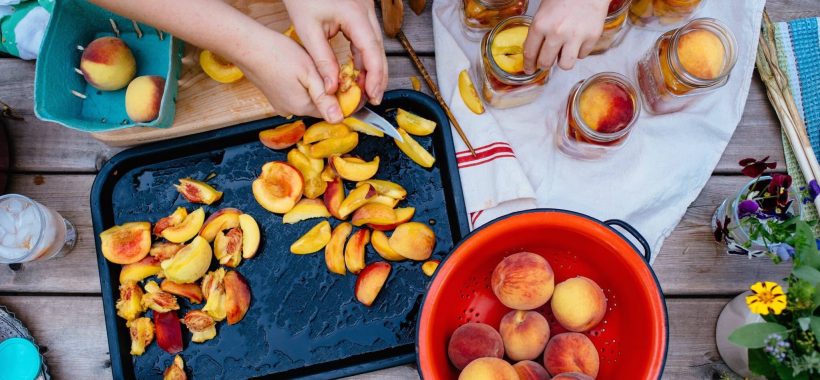
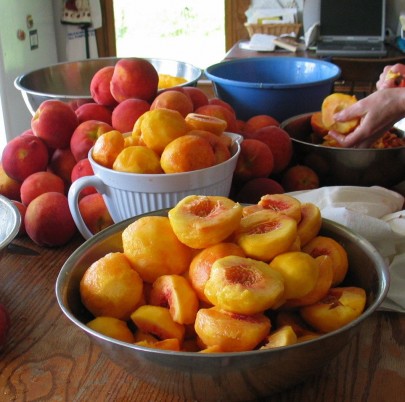
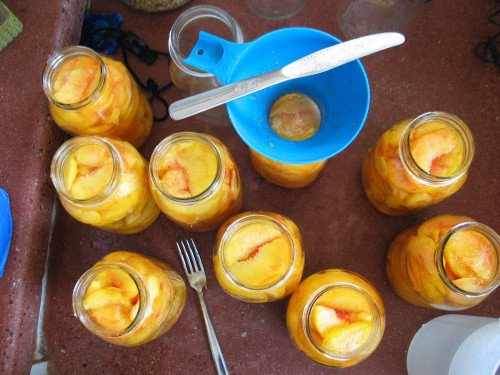
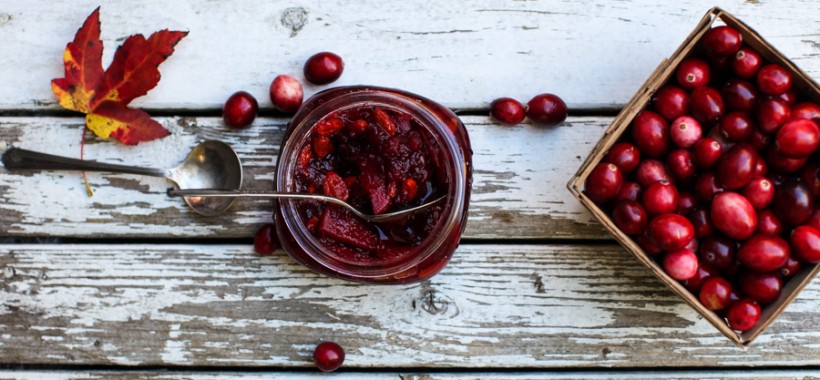
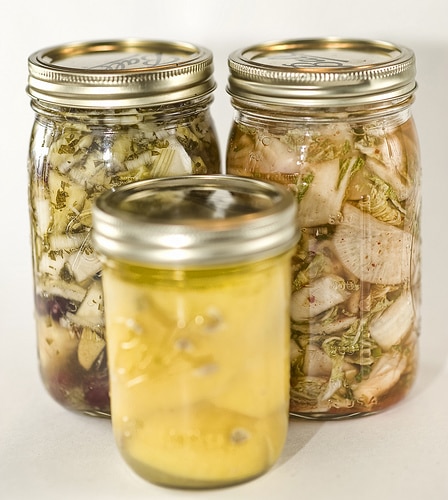

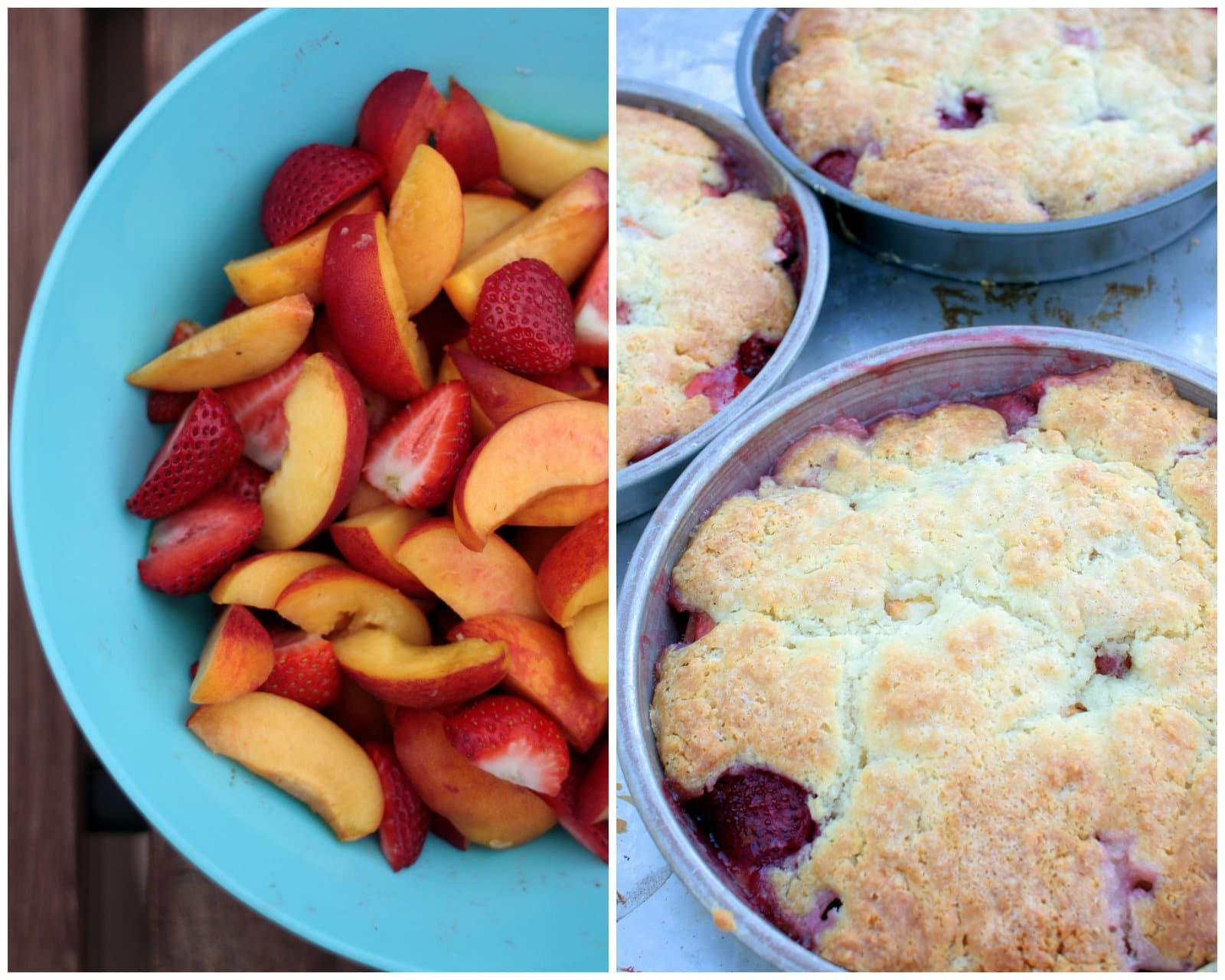
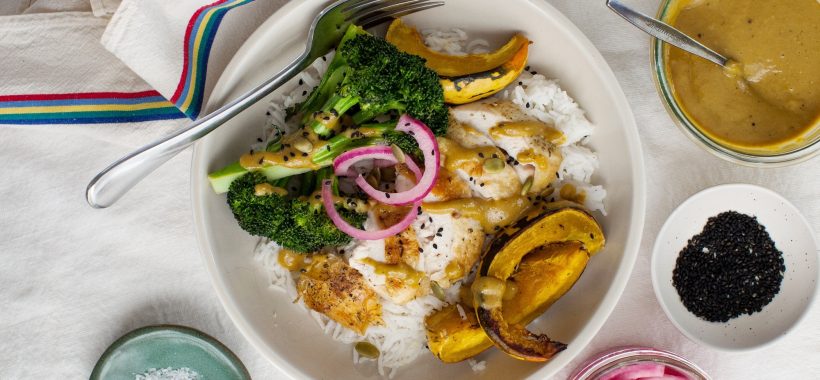
Do you have to add the sugar that is in your instructions? Could I can them without any sugar? or would that ruin them?
Hi Jen. I’ve never done it, so I can’t say for sure, but I don’t think it would hurt anything. I can my apricot puree without any sugar, choosing to add it when I open the jar, and it’s just fine. I think it would be the same for the peaches.
Maybe someone else out there has tried this? If so, your two cents are welcome…
I’m not sure about the sugar helping with food safety or not in this instance, but I know for sure it helps the fruit stay firm- if you packed them in water, they’d get very mushy! At least, that’s what happened to the apples I packed in water- they were so tender I could stir them into applesauce after I drained them.
Hmmm, but my no-sugar apricots are super mushy, and my peach-sugar syrup (no thickener, no water) is runny,..
If you can peaches without sugar, they do turn very brown. We did do it with orange juice, a thin juice…and that took longer to turn brown. If you want to preserve them without sugar, the freezer is a better method.
I have canned peaches, pears, apricots, and now nectarines all in a sugar free syrup. I use hot water and honey. It works well and keeps things fresh and doesn’t turn anything brown, its a natural sugar. I love it, and its relatively healthy.
I have been canning peaches for over 30 yrs and have never added sugar to my fruit I do use distilled water to fill my jars thou. My fruit does not turn brown and looks just as pretty 3 yrs later as they did the day I canned them.
I have always canned peaches with the skin on – after you process, the skin slips right off when you open the jar to use the peaches.
Great post! I’ve never thought of adding the sugar to each individual jar- I’ve always used a syrup. Is the water you add to the jars (after the sugar) hot? Cold? I just might have to try this- it’s sounds much simpler:-).
Thy Hand, I just use tap water, cool or lukewarm, whatever comes out when I turn it on. It eliminates one little step, but that’s worth something when you’re up to your eyeballs in sticky fruit, standing over a hot stove, feet aching, hair frizzed. There. How’s that for an appealing picture?!
Hi! I’ve normally canned peaches making syrup, but this year I canned them by just adding the sugar on top of the peaches, and then filling the jar with hot water. However, a few days later we’re noticing that there is sugar on the bottom of the jars. Is that ok? Why is that happening?
Thanks!
Hmm, I’ve never had sugar on the bottom of the jars. I do get a little fruit sediment that sinks to the bottom, but not sugar.
Did you add a lot of sugar? Or was it raw sugar (and therefore larger crystals)? Not that I think that should be a problem—I’m just wondering.
Did you not boil the jars long enough? Because if you boiled them for an adequate time, then the liquid inside the jars should be hot enough to dissolve any sugar crystals.
Sorry I’m not more helpful!
Thank you! Thank you! Thank you! My Grandmother has and had always been the big canner in my family. I have fond memories of going to her cellar and bringing up jars upon jars of peaches that I planned to eat while there and to bring home with me haha. Since she lives quite a distance from me, I haven’t been able to have her show me how she does it. My brother does can, and he can’s peaches every summer as well but getting the time between all of his kids and my own for him to beable to show me, has been impossible. Now I know how to can peaches! I was hoping you would post a canning tutorial for them! Thank you again!
I’ve never canned, but seeing those gorgeous peaches all canned up makes me wish I did. How gorgeous and tasty do those look? Yum!
I love canning peaches – you are right they taste amazing! However, I am surprised to see you mention the “open kettle method” of canning. (Placing hot food in hot jars and letting it cool to seal with no further heat treatment.) I have been told this is an out-dated canning practice that is no longer recommended. The food is exposed to bacteria and yeast in the air when you fill the jar, and then not heat processing the jars means you run the risk of having contaminated jars. You might be fine, but you might get sick – when it’s so easy to process the jars in boiling water – why take that risk?
Robin, You ask good questions. I’m so glad you brought them up.
(One clarification: the “open kettle method” refers to how the food is cooked; the process of putting boiling food in jars and then letting them seal themselves is called “hot-packing.”)
I hot-pack quite a few of my foods, such as sweet pickles, jellies, and grape juice concentrate. These foods are going straight from a boiling kettle into hot (oven-heated) jars; the chance of contamination is minimal.
This method is old-fashioned, I know. But canning is old-fashioned, too! Canning no longer “runs in the blood” and beginner canners run the risk of making mistakes (we all run risks, but I think you know what I mean)—I think it is for this reason that canning guidelines are so detailed and picky, when in truth, the process can be much more intuitive.
If hot-packing seems unsafe to you, then, by all means, put the jars through a hot water bath. I do this sometimes, even when I maybe don’t have to, because I just want to play it safe.
Happy canning!
My mother canned the open kettle method and her mother. Since I retired I have been canning more and my dear mother has passed on, so I search the internet. I became scared to use open kettle canning. So I water bathed everything. One day I looked up botulism stats. I was shocked after all the hula that there is average 145 cases of botulism reported in the US each year. 15% is caused from food processing. That makes 21 people a year. One thing they didn’t make clear is whether that was home canning or commercial canning. Do I want to be one of those 21 people absolutley not. It seems weekly we hear of commercial food poisoning reports. I trust that I and most home canners take more care of selecting and cleanliness when we preserve for our love ones food than commercial canning factories. Last year I almost died from Salmonella poisoning after eating a egg product out of a convience store. I am told that this happens all the time. It blows my mind that so much is put out to discourage home canning, when so few have become sick from it. After reading those stats I chose to go back to open kettling tomatoes and produce that were canned that way by our mothers and grandmothers. I am not trying to discourage anyone from taking that extra step in assuring food safety and being one of the 21 people by any means.
Hi Betty! Good for you for taking the time to think things through rationally and then acting according! A good dose of common sense goes a long way (and is much needed in today’s culture).
I love gardening, find it a quiet relaxing pass time. I planted fruit trees and vines over 20 years ago and enjoy reaping their rewards now. I only use chemicals when nothing else works. I have canned or froze over 700 quarts of produce this season in a drought. I’m not done yet. I have late peaches, grapes, applesauce, plums and yes I picked 6 more buckets of tomatoes today. This is my way of helping my grown children’s families fight the rising food costs and eat healthier produce than they might, due to rising costs of food, added preservatives and so so much salt in commercial foods. My grandchildren are my greatest asset. I simply would take the extra time to water bath if I could see more of a reason for it. Today I see more reason with continued reports of food poisoning from commercial food growers, food processors and convenience stores (ha) to put up as much produce as I can for them. Everyone has a choice but searching for this method of canning today is hard to find. I thank you for including it and giving people the option. I do think each person should research for themselves and do what they feel is the safest. I just hope other sites don’t discourage people from home canning their own healthy foods. When ask what I have been doing? I have heard so many say I just don’t feel it’s safe today to home can. I have to ask why? Thank you again.
I think you are right in calling it an intuitive process, I’m not there yet – still watching the timer and measuring every last thing. 🙂
You said “open kettle method refers to how the food is cooked; the process of putting boiling food in jars and then letting them seal themselves is called hot-packing.”
Maybe people use different terms? I understood “hot packing” to be heating the food before you put it in jars (like jams) and “raw packing” to be packing jars with unheated food (like pickles) and both methods are then heat processed. I was always taught that the open kettle canning term referred to the method of letting hot food cool to create a seal without further processing. I hot pack my jams and tomatoes but I still process them in boiling water.
Yeah, you’re probably right about the terms—people call the same process different things, and there’s more than one way to can. It sure can be confusing! The way I was taught, hot-packing means that you don’t process the jars in a hot water bath, but I’ve never bothered to look the definition up in the dictionary, and I very well could have my terminology all twisted up. Whatever you call it, as long as the food gets in jars and tummies are full, I’m happy!
The exact terms are confusing. My mother called it open kettle, but the explanation of hot packing is the same method of putting it in hot sterile jars hot and letting it seal.
I love canned peaches! I did over a bushel last year, and boy was I sick of peaches by the end, but they were my favorite thing I canned and we ran out of them too early! I peeled them by putting them in the boiling water, but I learned that if they are in there too long the flesh starts to get mushy, but if they aren’t in long enough, the skins don’t come off easily. So I ended up just canning half of them with the skins on. I figured, you eat the skin when you eat a fresh peach, so you can eat the skin from the can. And it tasted just fine.
I think I might do this too, Kaytee. I actually love the texture a peach skin brings, and almost always lave them on when I am cooking with peaches.
Great post. I received 2 lb. of peaches from my CSA share. I’ve been looking for recipes, because I’m concerned they’ll spoil. That was Tuesday. Today, I looked in the refrigerator, and only a quarter pound remained. I will dream of canning… peaches. one. day. Until now, this post takes the mystery out of canning stone fruit.
Thank you for the inspiration, Jennifer! I remember canning peaches with my mother as a child, but those long afternoons spent sitting on a stool, pitting peaches when I would rather have been playing outdoors left a tainted mark on my memory, I fear! Time to move on, grow up, I guess, and tackle my own peach preserves project.
You’ve made it all so attainable; thank you for your contribution.
Terrific post, Jennifer! When there’s no “canning queen” nearby to show how to can, it can be a scary thing to venture into it solo. Your tips are wonderful and you inspire me to put up a few jars this year.
I’m so excited to try this! I got a case of peaches today from my produce co-op. I’m heading out tonight to get jars! I may try to pack a couple of jars with agave rather than sugar to see what effect it has. Anyone tried this?
I have never worked with agave, so I really have no idea, but I can’t imagine that it wouldn’t work, but, seeing as I really don’t know, this response is totally non-helpful. Sorry. I’ll be quiet now.
Anyone else out there have a clue? If you do, it’s more than I’ve got!
If you want peaches that are really decadent try adding a Tablespoon or two of brandy before sealing. After a few weeks the peaches are even more wonderful than you can imagine. They are especially good spooned over poundcake with ice cream. Those jars didn’t last long enough!
Vicki, I am SWOONING. And now I can not WAIT for my four bushels of peaches that I ordered. I am so doing this. Bless you, dear.
Jennifer do you know why peaches come up from the bottom?
Wanda
No, I don’t know, but I just asked my science teacher dad and he said he doesn’t know but that it must be a density issue. The peaches become less dense when the sugars come out of the peaches and go into the water, which makes the water more dense and pushes the peaches up. That’s our best guess!
I enjoyed your post, although like Robin, I too was surprised that you mentioned using the open kettle method of canning and instructing people to simply let the jars seal on their own without processing them in a water bath canner for the correct time for their altitude.
While canning may be an old-fashioned process, there are many things from long ago that were considered safe that are now no longer considered safe for health. Health issues aside, using unapproved methods for canning in the name of being old fashioned puts one at risk not only for food borne illness, but also the loss in the time, effort, money and love and care put into producing a food, if it should go bad using a method such as open kettle canning.
I, too, believe that home food preservation is an important and lost/forgotten art, but there are ways to do this using modern knowledge to produce a safe, quality product.
The National Center for Home Food Preservation offers excellent advice and tips for how to do this.
http://uga.edu/nchfp
Article referring to methods best left in the past.
http://www.uga.edu/nchfp/how/general/equp_methods_not_recommended.html
Sarah, Thanks for your comment! There are many, many ways to do the same thing, and each person has his/her own limits for what they are comfortable with. I believe that our culture has gone overboard with safety issues (and not just in regards to food) and that fear can suck the living daylights out of us.
But now I’m getting off-track. We were talking about canning…
The methods I detailed in my post work great for me. I even reuse my canning lids (shh! don’t tell anyone!) to no ill effect. My experience is just that: my experience. Maybe it will inspire some to branch out and try new things, and maybe others will turn tail and run squealing in the other direction.
And really, what do I know? I’m just a mom-of-four, schlumping around my kitchen in my bare feet, playing with my food and trying to keep my head above water…
I reuse canning lids without nicks in them for years….but I have wasted food doing it the way you say you do it…even if they seal, it does not seal as well and keep out the bacteria like it should and you run the risk of wasting all your hard work. Water bathing is not hard and keeps them better!
Have you ever used honey instead of sugar for peaches or any other canned fruit?
I have never tried that, Michelle. Sorry, but I don’t think I can help you on that one. Anyone else have experience canning with honey in place of sugar?
I have always done my Peaches, Pears, Nectarines and Apricots in “Honey” water. It turns out great!! I only add enough honey to taste. I heat the water and then add as much or as little honey to the water to my taste, pour over the fruit, then seal them, waterbath them and it is done! They are amazing!! It is important to use your own local honey to get all the health benifits if you suffer from allergies. Otherwise, any honey will do.
I’m another one who uses the open kettle method (though I’ve never heard that term until today – hot pack would do it for me) for jams and pickles. But that’s normal where I’m from and it’s only low-acid foods that would be processed. The amount of sugar and/or vinegar combined with good hygiene while preparing and sterilising and filling your jars (I’m not sure I’d use a finger for wiping down rims for example but that might be because my fingers have a tendency to spend a lot of time in or near my mouth when I’m cooking 🙂 ) is more than sufficient for preserving purposes. The only time I’ve had things go wrong (a few jars of chutney the first year I made it) was because I overfilled the jars and didn’t check that the rims were really clean before closing the lids.
Anyway, that wasn’t what I really wanted to say. I haven’t done any processing with honey but I remember reading on a blog (two frog home I think) once about a book, which has been on my wishlist since. Here’s a link to it on amazon today (saying that because who knows who might be reading this post in 20 years time when the link might not work anymore!): http://www.amazon.com/Putting-Up-Honey-Preserving-Cookbook/dp/0930356136 – it’s called Putting it Up with Honey.
Great article on canning peaches. Nothing tastes better come January than a “fresh” peach! I’ve canned peaches for the last 3-4 years now and they’ve always turned out great but I have one question. When I pour water in my jars I really try to pay careful attention to how much head space I leave. However, after the water bath it seems that I have much less water in the jars and the tops of my peaches are exposed. Does anyone know what I’m doing wrong?
Karen, that happens to me sometimes, too. I think it’s because we aren’t getting all the pockets of air out of the jar—then when the fruit cooks, it compresses and the bubbles rise to the surface, and voila, there’s more head space then we started out with. It might help if you use a table knife to gently push the peaches to one side while adding the water. Go at it from several angles. You might want to even knock the jar on a wadded-up towel on the counter. Hope that helps!
can you can the peaches if they have been cooked already and stored in the fridge?
Ricardo
Yes. If they taste good in the fridge, then they should still taste good in jars. Just make sure that you process them long enough to get them to heat all the way through—perhaps five minutes longer than you would with peaches that started out at room temperature.
Great information… I have a bunch of peaches to can. I did a test run yesterday using a very light syrup. After a hot water bath for 25 minutes per the Ball Blue Book, the peaches really shrank and are a little soft to mushy..
Before I proceed with the remaining 25 pounds, I hope to find out why they shrank and why they would be so soft. They were not over ripe when I started.
Any suggestions?
Thank you
Debbie
Hi Debbie. I think they probably shrank because of extra air space in the jars. All canned fruit rises to the top thanks to the extra air space. Perhaps you had larger cuts of fruit and larger air holes as a result?
As for them getting mushy: it could be due to the type of peach (one that I’m not familiar with?) or the long processing time. I water bath my canned goods for less than the recommended time (and endure a bit of tsk-tsking from the by-the-bookers) because of this very thing—I’m afraid of mushy fruit.
Those are my two best guesses. I hope it helps!
I tried these a few days ago, and am so pleased with my results! Thanks! I also tried out the tomato sauce recipe on your blog, and have shared both on mine 🙂
It is refreshing to know there are others out there who dismiss the extreme measures recommended in the name of safety. Yes, be clean, but really is it necessary to boil the crap out of ’em? My grandmother used the hot-pack method and I like it because it’s SO much faster. Boiling 3-4 jars at a time for 30 minutes would take hours extra, and for what? Mushy peaches.
Hi,
I love your site. Can you please clarify as this will be my frist time canning.
When you state, “next day, remove the rings, wash the jars with soapy water”, does this mean you boil the cans with the lid on and then the next day remove the lid (with the ring), wash the jars and then re-lid?
Thanks in advance
Theresa
@beauty0natural
Hi Theresa,
I’m glad you like the site! Welcome!
There are two parts to the lids: the actual lids which adhere to the jar, and the ring which keeps the lid in place while the jars are boiling/sealing. So when washing the jars of canned fruit, simply remove the ring. The lid stays on.
hey can anyone tell me after canning peaches when I can start eatting them?
Hi Joe,
You can dig in whenever you want!
Happy Eating!
Jennifer
You are doing people a disservice by not giving proper canning instructions. While there is less danger with canned fruits than canned vegetables, you still run the risk of improperly preserving your fruit and possibly making someone sick. Even if you use the open kettle method, you must still process your fruit in a boiling water bath. Processing times are not up for interpretation, either. For up to date instructions, people should visit a reputable site, such as the National Center for Home Food Preservation (http://www.uga.edu/nchfp/) or their local extension service. As far as Grandma’s methods go, Grandma wasn’t right, she was lucky.
@ heather d. grandma kept the whole fam damily alive. may hap she knew what she was doing. now back up off of grandma.
so you only boil for 10-15 min? What alt are you at? I am at almost 6000 ft you think I could get away with that long too?
We’re around 1400 feet. I have no idea about canning at that altitude since I’ve never done it. Google it, maybe? I’m sorry I can’t be more helpful… But if you figure it out, do report back, ‘kay? I’m sure others would appreciate knowing.
I have been wondering about using sugar substitutes in canning… any ideas?
Thanks for you recipe but to make it easier for us beginners a picture step by step pictorial would be nice!
I have attempted to can peaches in the past, but after canning, they always turn brown on top. How can I prevent this? I end up throwing them out!
Canned fruit turns brown because there is air in the jars—perhaps there was too little processing time? Or, it can be because the fruit was over-processed. It can also be the result of fruit being past its prime, or maybe iron or copper kettles were used in the canning process? Sometimes that can discolor the fruit.
My peaches often change color around the top. Sometimes it’s just a very light tinge and other times the top half-inch or so gets quite brown. It’s not attractive, so I just serve them to family. As long as the seal is good, I don’t throw them out.
We add 1/2 tsp. lemon juice per pint jar to prevent browning. The peaches are beautiful and there is no taste of lemon.
I canned peaches in 2009, using ascorbic acid in each jar before sealing, are they still good to eat? They look fine, but I am afraid after so long a time. What a shame, I found them hidden in a box covered with a towel. I thought we had eaten them all. Thanks so much for any info you can give me.
Good news: if the seal is still good, then they’re fine! Enjoy your hidden fruits!
Are you supposed to have the water boiling when you put the cans into the pan, or let the cans warm up with the water?
Great post! Very helpful!
Let the jars warm up with the water. If you put room temp jars into boiling water, they’ll break. In between canning batches, I always scoop out about half of the water and replenish with cold in order to bring the temperature down BEFORE adding the next batch of jars. Good luck!
I’m new to canning and am wondering if I can prepare the peaches in the jars but then actually seal them in a hot water bath the next day? Will the peaches be ok overnight? Should I be storing them in the refrigerator overnight? Or am I totally out in left field and the process should be done all at once? Thanks!
You COULD prep them ahead of time and then can them the next day, but I don’t recommend it. The peaches may turn brown and get a little mushy. They’d be macerating overnight, so they’d get saucier, which might not be the best. Also, they would definitely need to be stored in the fridge, so you’d be using energy to cool them and then extra energy to heat them back up…which seems counterproductive. But you can always try it and see what happens. Just make sure you cook them for longer in the canner to make sure they get good and hot on the inside.
Wonderful, what a weblog it is! This blog presents
helpful facts to us, keep it up. https://lesallecreams.com/
regarding putting about a 1/3 cup of sugar in each jar – is that for a quart?
I am going to use pint jars for the peaches – first time canning peaches!! – not sure on sugar.
Yes, about a third cup of sugar per quart (though lately I’ve been using less — maybe just a fourth cup). Good luck!